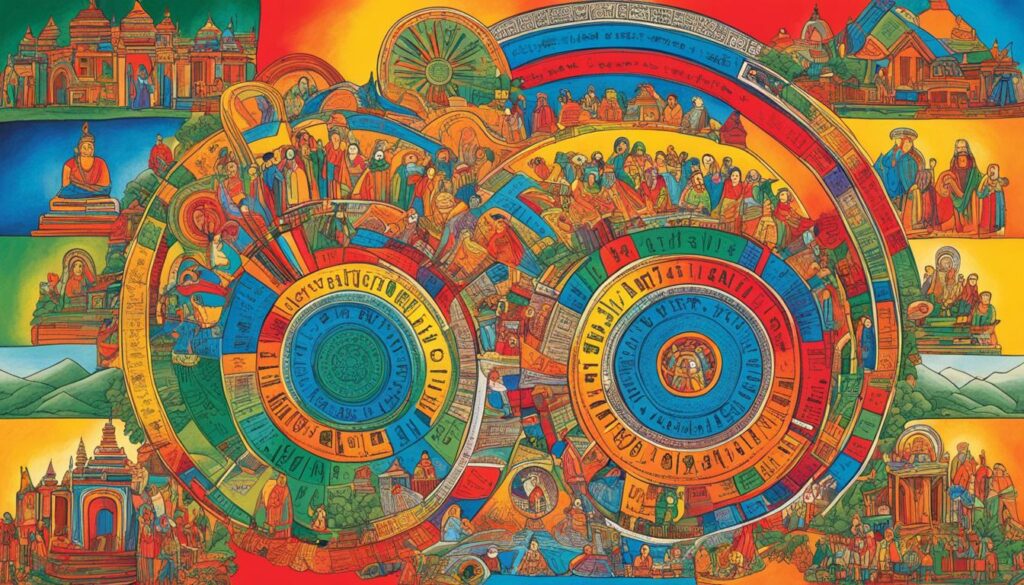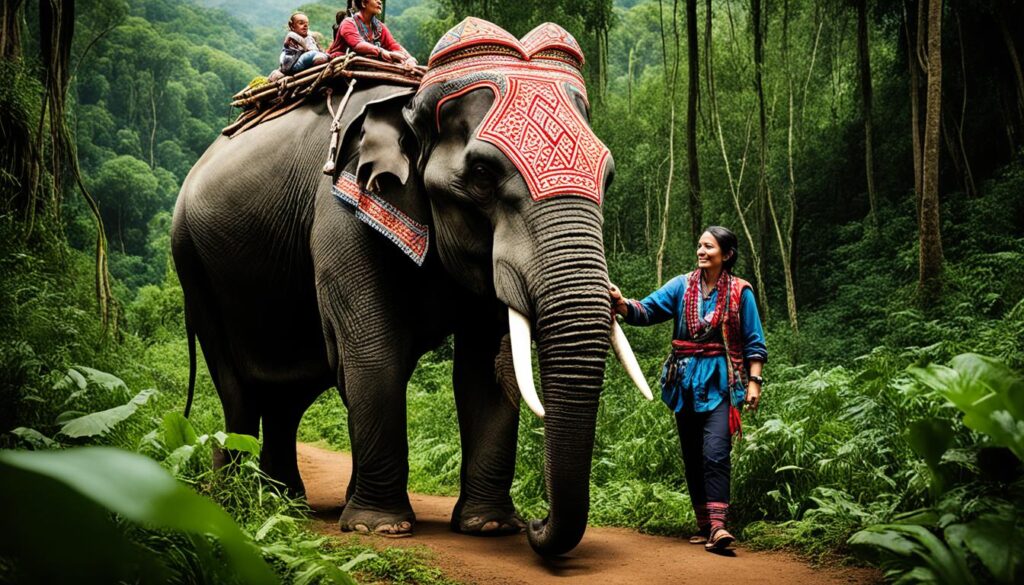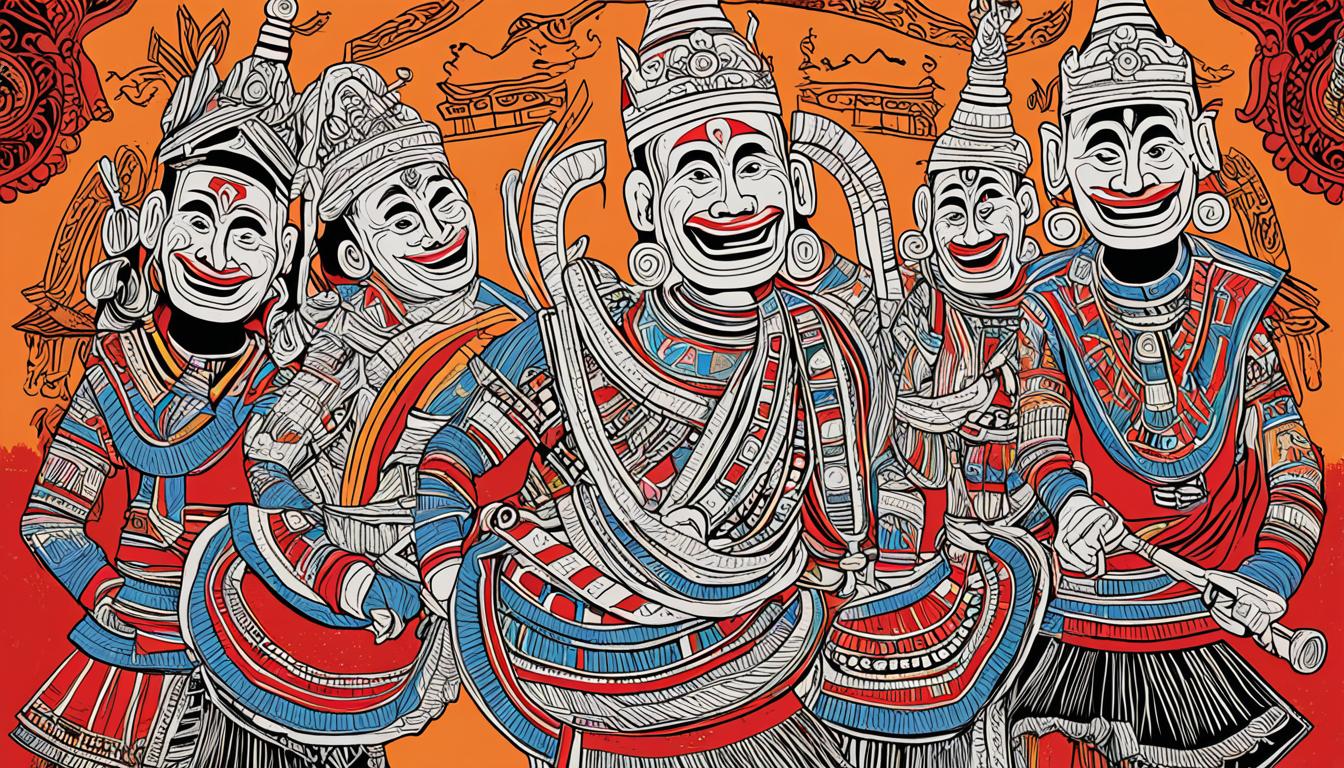Did you know that the Padaung Karen language is spoken by approximately 4.5 million Karen people in Thailand and Myanmar? This surprising statistic highlights the significance of the Padaung Karen language within the Karen hill tribe community. As one of the branches of the Karenic languages, which also include Sgaw, Pwo, Pa’O, Karenni, and Kayan, the Padaung Karen language represents a unique cultural and linguistic heritage.
The Padaung Karen language is classified as part of the Sino-Tibetan language family and is written using the Karen script. Its subject-verb-object word order, influenced by neighboring Mon and Tai languages, adds to its distinctiveness. Through the preservation and revitalization of the Padaung Karen language, the Karen hill tribe community seeks to maintain their cultural traditions, strengthen their cultural identity, and promote intergenerational communication.
Origins and Migration of the Karen Hill Tribe
The Karen hill tribe people have a fascinating history of origins and migration. While the exact details remain uncertain, it is believed that they originated from the Tibetan region or the vast expanse of the Gobi Desert. For many centuries, the Karen people have called Burma (Myanmar) their home. However, in the 18th century, a significant migration took place as they began relocating to various parts of Thailand. The exact reasons that prompted this migration are still not fully known.
Today, the Karen people can be found in fifteen provinces in Thailand, predominantly along the border with Myanmar. They have established settlements in diverse regions, such as Chiang Rai, Chiang Mai, Mae Hong Son, Tak, Kanchanaburi, and the Isthmus of Kra.
“The Karen hill tribe people have a rich history of migration, with their origins traced back to the Tibetan region or the Gobi Desert.”
Karen Language Subgroups
The Karen hill tribe, known for their rich linguistic diversity, is divided into several distinct language subgroups. Each subgroup has its own unique dialect and contributes to the overall Karen linguistic landscape. The main Karen language subgroups include:
-
Sgaw Karen
Sgaw Karen, also known as Karen or Pakayor, is the largest subgroup and is often referred to as the “common Karen” dialect. It is widely spoken among the Karen community and serves as a lingua franca for communication.
-
Pwo Karen
Pwo Karen encompasses four distinct dialects: Eastern Pwo, Western Pwo, Northern Pwo, and Phrae Pwo. Each dialect has its own unique linguistic features and is spoken by specific Karen communities.
-
Pa’O Karen
Pa’O Karen, also known as Black Karen, have their own distinct language and dress style. They are recognized as a separate subgroup within the Karen community.
-
Kayah Karen
Kayah Karen, also known as Karenni, form a separate subgroup within the Karen hill tribe. They have their own distinct language and cultural practices.
-
Kayan Karen
Kayan Karen, also known as Padaung, are well-known for the “Long Neck” women. They maintain their own unique dialect within the Karen linguistic family.
The Karen language subgroups exhibit linguistic diversity, with each dialect reflecting the cultural and historical influences of the respective community. This linguistic variety enhances the overall richness of the Karen hill tribe’s cultural heritage.
| Subgroup | Distinct Features |
|---|---|
| Sgaw Karen | Widely spoken as a lingua franca among the Karen community |
| Pwo Karen | Four distinct dialects: Eastern Pwo, Western Pwo, Northern Pwo, and Phrae Pwo |
| Pa’O Karen | Distinct language and dress style |
| Kayah Karen | Separate subgroup with its own distinct language and cultural practices |
| Kayan Karen | Known for the “Long Neck” women and unique dialect |

This image visually represents the diversity of Karen language subgroups, highlighting their distinct cultural and linguistic characteristics.
Karen Hill Tribe Culture and Religion
The Karen hill tribe is renowned for its vibrant culture, steeped in traditions that have been passed down through generations. From their distinctive traditional dress and exquisite textiles to their spiritual practices, the Karen people have a rich cultural heritage that reflects their deep connection to their land and beliefs.
Karen Traditional Dress and Textiles
The Karen people are highly skilled weavers, known for creating intricate textiles using traditional methods. Their traditional dress, adorned with vibrant colors and intricate patterns, is a remarkable display of their craftsmanship and cultural identity. Each Karen subgroup has its own unique style of dress, allowing for a rich tapestry of diversity within the tribe.
Karen Traditional Practices: Animism, Spirituality, and Religious Influence
Animism lies at the heart of Karen traditional practices. The Karen people believe that every natural entity possesses a spiritual essence. They hold a deep reverence for nature, observing and acknowledging the spiritual presence in animals, plants, rivers, and even everyday objects.
As part of their animistic beliefs, the Karen people engage in spiritual rituals and ceremonies to honor and seek guidance from the spiritual realm. These practices are led by the village priest, who plays a pivotal role in the Karen community, ensuring the spiritual well-being and harmony of the tribe.
“The Karen people’s animistic practices are a testament to their profound connection with their natural surroundings. It is a way of life that has shaped their identity and instilled a deep respect for the world around them.”
Throughout history, the Karen people have encountered various external influences that have had a profound impact on their religious beliefs. With the arrival of Christian missionaries in the 19th century, many Karen individuals converted to Christianity. Today, Christianity plays a significant role in the lives of many Karen people, coexisting with their traditional practices.
Additionally, some Karen people also embrace Buddhism, blending elements of Buddhist teachings with their traditional animistic beliefs. This religious diversity within the Karen community further contributes to the cultural tapestry of the tribe.
Karen Traditional Practices and Rituals
Various traditional practices and rituals are an integral part of Karen culture. These include annual festivals, ceremonies, and rites of passage. Celebrated with joy and reverence, these events bring the Karen community together and reinforce their cultural identity.
Here are some of the key traditional practices and rituals:
- Rice planting ceremony: An important ritual that marks the beginning of the rice planting season. It involves prayers and offerings to ensure a bountiful harvest.
- New Year festivities: Karen New Year celebrations are vibrant and colorful, with traditional dances, music, and cultural performances. These festivities usually take place in November and are a time of celebration, reflection, and unity.
- Harvest festival: Celebrated to express gratitude for a successful harvest, the harvest festival is a time for the Karen people to come together, sharing food, stories, and laughter.
The preservation of these traditional practices and rituals is vital for the continuity of Karen culture and the passing on of their heritage to future generations.
Karen Religious Practices
| Religious Practices | Influence |
|---|---|
| Animism | Deep connection with nature, spiritual reverence for natural entities. |
| Christianity | Influence of Christian missionaries in the 19th century, resulting in a significant number of Karen people converting to Christianity. |
| Buddhism | Coexistence of Buddhist teachings with traditional animistic beliefs among some Karen individuals. |
The religious practices of the Karen people highlight their adaptability and openness to spiritual beliefs, blending their ancestral traditions with external influences.
The Karen hill tribe’s cultural heritage and religious practices serve as a testament to their resilience, rich diversity, and steadfast connection to their ancestral roots. The preservation and celebration of Karen culture are essential not only for the tribe but also for fostering cultural understanding and appreciation among others.
Livelihood and Lifestyle of the Karen People
The Karen hill tribe has a unique way of life centered around their livelihood and sustainable practices. Let’s explore their farming techniques, environmental consciousness, and long-standing tradition of elephant ownership.
Karen Farming Practices
The livelihood of the Karen people primarily revolves around subsistence rice farming. They practice shifting cultivation techniques, moving their fields instead of their villages to preserve the forest. This traditional approach allows the land to regenerate and maintain its fertility over time. The Karen people’s farming practices are deeply rooted in their cultural heritage and intimate connection with the natural environment.
Karen Environmental Consciousness
The Karen hill tribe is known for their environmental consciousness and commitment to preserving the balance of the ecosystem. They practice crop rotation, a sustainable farming method that helps maintain soil fertility and minimize the use of chemical fertilizers. By rotating their crops, the Karen people protect the land from degradation and promote sustainable agriculture. Their deep respect for nature and understanding of its interconnectedness guide their farming practices.
Karen Elephant Ownership
Within the Karen culture, owning elephants holds significant cultural and historical importance. Communities like Huay Pha Koot in Mae Chaem district have a long-standing tradition of elephant ownership. These gentle giants have been a part of the Karen people’s lives for centuries, serving as symbols of power, strength, and unity. The Karen’s elephant ownership showcases their deep connection to the natural world and their reverence for its creatures.

“Our farming practices and environmental consciousness are deeply intertwined with our cultural heritage. We strive to cultivate the land responsibly, maintaining a harmonious relationship with nature.”
Through their sustainable farming practices, environmental consciousness, and deep-rooted tradition of elephant ownership, the Karen people exemplify a harmonious way of life that respects and preserves the natural world they call home. Their livelihood not only sustains them but also serves as a testament to their deep cultural heritage and the importance of preserving it for future generations.
Karen Festivals and Celebrations
The Karen hill tribe is known for its vibrant festivals and traditional celebrations that showcase their rich cultural heritage. These events provide a glimpse into the Karen community’s customs, beliefs, and way of life. From Christian festivals to Buddhist celebrations, the Karen people have a diverse range of festivities that hold great significance to their identity.
Christian Festivals
Many Karen individuals have embraced Christianity, and as a result, they celebrate Christian festivals such as Christmas and Easter. These occasions are marked with religious services, feasts, and gatherings, where Karen families and communities come together to commemorate the birth and resurrection of Jesus Christ. During Easter, the Karen also participate in the tradition of “finding the egg,” which brings joy and excitement to both children and adults.
Buddhist Celebration – Karen New Year
The Karen community also pays homage to their Buddhist roots through the celebration of Karen New Year, known as “Nee Saw Ko.” This festival, which takes place in January, is an important occasion for the Karen people. It is a time for reflection, gratitude, and renewal as they welcome the arrival of the new year. The Karen New Year celebration includes various cultural activities and rituals, such as traditional dances, music performances, and religious ceremonies.
Songkran Parade
Another notable event in the Karen calendar is the Songkran parade. Songkran is the traditional Thai New Year, and the parade serves as a platform for the Karen community to showcase their cultural heritage. The parade features colorful costumes, traditional music, dance performances, and beautifully decorated floats that depict scenes from Karen folklore and history. It is a joyful and festive affair that brings together people from different backgrounds to celebrate and appreciate the rich traditions of the Karen hill tribe.
Karen Festivals and Celebrations
| Festival/Celebration | Description |
|---|---|
| Christmas | A Christian festival celebrated to commemorate the birth of Jesus Christ. It is a time for prayer, reflection, and gathering with loved ones. |
| Easter | A Christian festival celebrating the resurrection of Jesus Christ. The Karen community participates in the tradition of “finding the egg” during Easter. |
| Karen New Year (Nee Saw Ko) | A Buddhist celebration held in January to welcome the new year. It involves cultural activities, rituals, and religious ceremonies. |
| Songkran Parade | A traditional Thai New Year parade where the Karen community showcases its cultural heritage through costumes, music, dance, and floats. |
Language and Communication in the Karen Community
Language plays a crucial role in the Karen community, serving as a fundamental means of communication and cultural expression. The Karen hill tribe has several distinct language subgroups, including the Padaung Karen language, which is spoken within the community and at home.
However, the teaching of the Karen language in formal education has been limited. Most educational institutions in Thailand focus on Thai as the primary language of instruction, leaving little space for the inclusion of Karen language learning.
Karen Language in Education:
“Currently, the Karen language is not given adequate attention in the formal education system, which poses challenges in preserving and transmitting the language to younger generations.”
Despite these limitations, efforts have been made to revitalize and preserve the Karen language. Various organizations and individuals are working tirelessly to promote Karen language education and documentation, ensuring its survival for future generations. These initiatives aim to foster a sense of pride and cultural identity among the Karen community.
Karen Language Revitalization:
“Revitalizing the Karen language is crucial for preserving the cultural heritage and identity of the Karen hill tribe. By fostering language revitalization initiatives, we can ensure that the Karen language thrives for generations to come.”
Preserving the Karen language is not only about linguistic diversity but also about maintaining the cultural traditions and values that are intertwined with the language. It is through language that stories are told, traditions are passed down, and a sense of belonging is nurtured.
Karen Language Preservation:
“Preserving the Karen language is not only a linguistic endeavor but a holistic effort to safeguard the cultural heritage and knowledge of the Karen hill tribe.”
Recognizing the importance of the Karen language, it is essential to continue supporting initiatives that promote Karen language education and documentation. This includes the development of language learning materials, the establishment of language schools, and the inclusion of the Karen language in educational curricula.
Importance of Karen Language Communication:
The Karen language serves as a crucial medium for intergenerational communication, fostering connections between elders and younger community members. It allows for the transmission of traditional knowledge, cultural practices, and values, ensuring the continuity of the Karen heritage.
“Karen Language Communication is the bridge that connects generations, fostering a sense of belonging and cultural continuity within the Karen community.”
Efforts to promote Karen language communication not only benefit the Karen community but also contribute to the overall linguistic diversity and cultural richness of Thailand.

Conclusion
The Padaung Karen language holds a significant place within the cultural heritage of the Karen hill tribe. As part of the diverse linguistic and cultural background of the Karen people, this language represents a unique aspect of their identity. The migration of the Karen hill tribe to Thailand and their settlements in various provinces have played a crucial role in the preservation and transmission of the Padaung Karen language and its associated traditions.
In order to ensure the longevity of the Padaung Karen language and promote cultural awareness, efforts to revitalize and preserve this language are of utmost importance. By focusing on linguistic preservation and cultural revitalization, the linguistic and cultural diversity of the Karen community can be maintained. These efforts not only help preserve a valuable language but also contribute to a deeper understanding of the history, culture, and identity of the Karen hill tribe.
By recognizing and appreciating the significance of the Padaung Karen language, we can gain valuable insights into the rich cultural heritage of the Karen people. The preservation and promotion of the Padaung Karen language are essential for the continued appreciation and study of the Karen hill tribe’s language diversity. Through these efforts, the Karen community can ensure that future generations have the opportunity to connect with their linguistic and cultural roots.
FAQ
What language do the Padaung Karen people speak?
The Padaung Karen people speak the Padaung Karen language, which is part of the Karenic language family.
How many Karen languages are there?
There are several Karen languages, including Sgaw Karen, Pwo Karen, Pa’O Karen, Kayah Karen, and Kayan Karen.
Where did the Karen hill tribe originate from?
The exact origins of the Karen hill tribe are uncertain, but they are believed to have originated from the Tibetan region or the Gobi Desert.
Why did the Karen hill tribe migrate to Thailand?
The reasons for the Karen hill tribe’s migration to Thailand are not fully known, but they began migrating in the 18th century.
What are the main language subgroups of the Karen hill tribe?
The main language subgroups are Sgaw Karen, Pwo Karen, Pa’O Karen, Kayah Karen, and Kayan Karen.
What is the Karen hill tribe known for culturally?
The Karen hill tribe is known for their traditional dress, textiles, weaving skills, and the practice of animism as their primary religion.
What is the primary livelihood of the Karen hill tribe?
The primary livelihood of the Karen hill tribe is subsistence rice farming, practicing shifting cultivation techniques.
What festivals do the Karen hill tribe celebrate?
The Karen hill tribe celebrates a variety of festivals, including Christian festivals like Christmas and Easter, as well as traditional celebrations like the New Year.
How is the Karen language preserved and promoted?
Efforts are being made to revitalize and preserve the Karen language through education, documentation, and cultural awareness initiatives.
